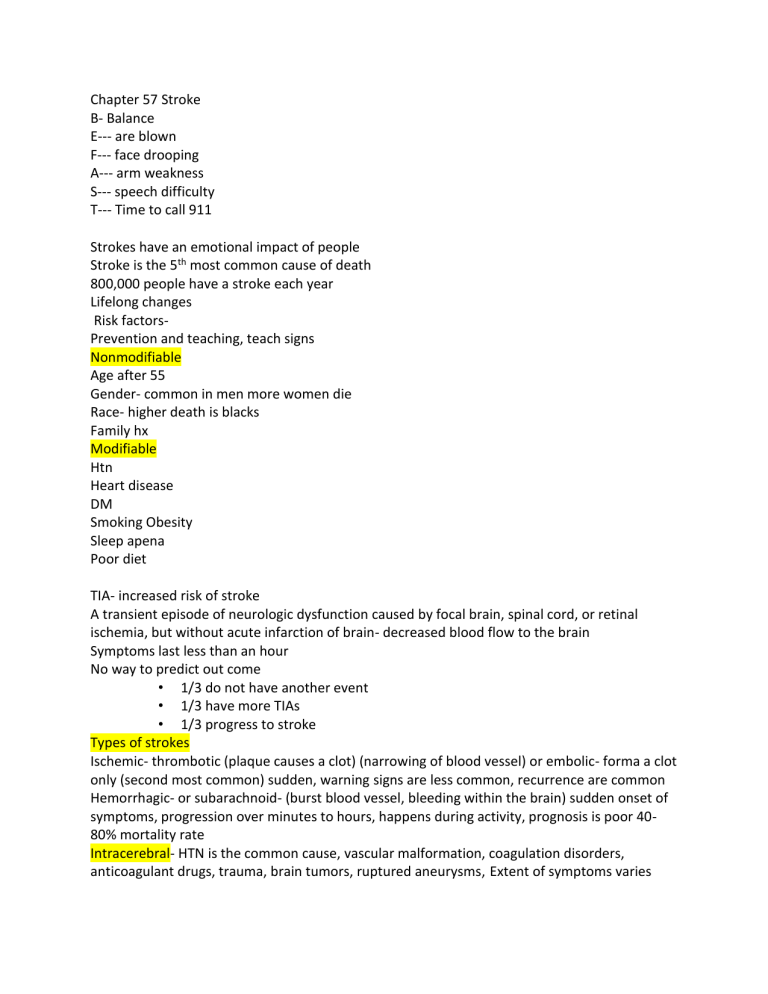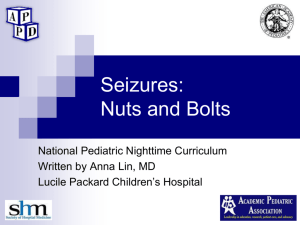
Chapter 57 Stroke B- Balance E--- are blown F--- face drooping A--- arm weakness S--- speech difficulty T--- Time to call 911 Strokes have an emotional impact of people Stroke is the 5th most common cause of death 800,000 people have a stroke each year Lifelong changes Risk factorsPrevention and teaching, teach signs Nonmodifiable Age after 55 Gender- common in men more women die Race- higher death is blacks Family hx Modifiable Htn Heart disease DM Smoking Obesity Sleep apena Poor diet TIA- increased risk of stroke A transient episode of neurologic dysfunction caused by focal brain, spinal cord, or retinal ischemia, but without acute infarction of brain- decreased blood flow to the brain Symptoms last less than an hour No way to predict out come • 1/3 do not have another event • 1/3 have more TIAs • 1/3 progress to stroke Types of strokes Ischemic- thrombotic (plaque causes a clot) (narrowing of blood vessel) or embolic- forma a clot only (second most common) sudden, warning signs are less common, recurrence are common Hemorrhagic- or subarachnoid- (burst blood vessel, bleeding within the brain) sudden onset of symptoms, progression over minutes to hours, happens during activity, prognosis is poor 4080% mortality rate Intracerebral- HTN is the common cause, vascular malformation, coagulation disorders, anticoagulant drugs, trauma, brain tumors, ruptured aneurysms, Extent of symptoms varies and depends on amount, location, and duration of bleeding. S/S- HA, nausea, vomiting, HTN, decreased level of consciousness. Subarachnoid hemorrhage (SAH) • Intracranial bleeding into cerebrospinal fluid–filled space between arachnoid and pia mater • Often caused by rupture of a cerebral aneurysm, trauma, or illicit drug use Cerebral aneurysm • Most are in Circle of Willis • Incidence increases with age; higher in women • Silent killer • Loss of consciousness may or may not occur • High mortality rate • Survivors often suffer significant complications and deficits Deficits depend on location of stroke: when were you last seen normal, we have 4 hours to get help. Right and left-brain stroke If you have a stroke on the right the effect will show on the left Test question Right side Spatial Impaired judgment Impulsive Incorrect perception of self and illness Unilateral neglect of affected side Homonymous hemianopsia- Can only see half of your plate • Agnosia- recognition • Apraxia- movement Left side Depression and anxiety Aware of deficits Motor functionMotility Respiratory function Swallowing and speech Gag reflux Self-care Loss of skilled voluntary movement Akinesia Changes in muscle tone Altered reflexes- faster bigger reflexes Changes from hyporeflexia to hyperreflexia Initial period of flaccidity- may last from days to weeks related to nerve damage Aphasia- communication (without) • Receptive: loss of comprehension • Expressive: loss of production of language • Global: total inability to communicate Dysphagia (impaired) • Nonfluent • Minimal speech activity with slow speech • Fluent • Speech is present but has little meaningful communication Dysarthria- problems with muscular control of speech Impairment may involve pronunciation, words, articulation, phonation AffectsHard time controlling emotions Depression, change in body image, loss of function Both memory and judgment may be impaired Elimination- may have problems with urinary and bowel function but are temporary. Diagnostic MRI or CT- are the very first imaging done CTA or MRA • Cerebral angiography • Digital subtraction angiography • Transcranial doppler ultrasonography • Lumbar puncture • LICOX system- monitors the oxygen in the brain Manage: Health diet Weight control Exercise No smoking Limit alcohol BP Carotid endarterectomy- cleaning out the blockage in the artery Post op- neuro checks. Manage BP, monitor for stent occlusion, minimize the risk of bleeding Acute care for stroke Preserve life Prevent further damage Remember the time of onset tPA- must be started with in 4 hours of onset, given to reestablish the blood flow, pt’s are carefully screened. REMEMBER ABC’S Goals- ABC’s Medications- Calcium channel blocker nimodipine treats vasospasms and minimize cerebral damage Nimodipine-KNOW MEDICATION TEST QUESTION Chapter 58 HA Most common people have • Migraine headaches • Tension-type headaches • Primary headaches are not caused by disease or another medical condition • Tension-type, migraine, cluster • Secondary headaches are caused by another condition or disorder • For example, sinus infection, neck injury, or brain tumor Tension-type- most common, bilateral pian, usually mild Nero issues- episodic to chronic s/s bilateral frontal, constant, dull, pressure, band-like, ASA, muscle relaxers, antidepressants, antiseizure meds Migraine- one sided, premonitory triggers, 25-55, Risk factors- age female, obesity, depression, without aura s/s- sleep mood, cognitive changes, visual, unilateral pain. Cluster- repeated HA same time day and night, onset 20-50 One sided pain, triggers include alcohol and strong odors s/s- sharp stabbing, intense pain last 3 min to 3 hours, may occur every other day can last 2 weeks to 3 months, 100% oxygen at 6 to 8 L/min for 10 min- Triptans Rebound HA- Medication overuse headache (MOH) is an analgesic rebound headache Some HA can be cause by different issues. Seizures- chapter 29 • Transient, uncontrolled electrical discharge of neurons in brain, interrupting normal function • May accompany other disorders or occur without any apparent cause • Metabolic problems that may cause seizures include • Acidosis • Electrolyte imbalances • Hypoglycemia • Hypoxemia • Alcohol or barbiturate withdrawal • Dehydration or water intoxication Extracranial disorders that may cause seizures • Systemic lupus erythematosus • Diabetes • Hypertension • Sepsis • Heart, lung, liver, or kidney diseases Common cause during the first 6 months • Severe birth injury • Congenital birth defects involving CNS • Infections • Inborn errors of metabolism Common causes from ages 2 to 20 years • Birth injury • Infection • Head trauma • Genetic factors 20 and 30 years • Structural lesions • Trauma • Brain tumor • Vascular disease Common causes after age 50 years • Stroke • Metastatic brain tumors • 1/3 of cases are idiopathic • Idiopathic generalized epilepsy (IGE) • Not attributable to a specific cause Three major classes • Generalized onset • Focal onset • Unknown onset Phases Prodromal phase• Aural phase• Ictal phase• Postictal phaseTonic-clonic seizures • Characterized by loss of consciousness and falling to the ground • Body stiffens (tonic) with subsequent jerking of extremities (clonic) • Cyanosis, excessive salivation, and tongue or cheek biting, incontinence Typical absence seizure • Usually occurs only in children and rarely beyond adolescence • May stop as child matures, or may evolve into another type • Brief staring spell, lasts less than 10 seconds Atypical absence seizures • Characterized by staring spell with other manifestations • Eye blinking • Jerking movements of the lips • Lasts more than 10 seconds • Usually continue into adulthood Myoclonic seizure • Characterized by rhythmic arm abduction (3 movements per second) leading to progressive arm elevation • Usually lasts 10 to 60 seconds • Eyelid myoclonia refers to jerking of the eyelids Focal-onset seizures • Formerly called partial or partial focal seizures • Begin in specific region of cortex in one hemisphere of brain • • • • • Psychogenic seizures • • • • Produce manifestations based on function of area of brain involved Focal awareness seizures Focal impaired awareness seizures Sudden and unexplainable feelings of joy, anger, sadness, or nausea May hear, smell, taste, see, or feel things that are not real Can be misdiagnosed as seizure disorder Proper diagnosis usually requires use of video-EEG monitoring History of emotional or physical abuse or traumatic event may emerge Status epilepticus (SE)- State of continuous seizure activity or condition when seizures recur in rapid succession without return to consciousness between seizures This is a neurologic emergency, causes the brain to use more energy than supplies Convulsive status epilepticus • Most common form • Prolonged or repeated tonic-clonic seizures • Can lead to fatal respiratory insufficiency, hypoxemia, dysrhythmias, hyperthermia, and systemic acidosis • • Nonconvulsive status epilepticus • Long or repeated focal impaired awareness seizures Refractory status epilepticus (RSE) • Continuous seizure activity despite administration of first and second line therapy How do we DX: history , EEG • Magnetoencephalography (MEG) may be done with EEG • Greater sensitivity in detecting small magnetic fields of neuronal activity • CBC, serum chemistries, liver and kidney function, UA to rule out metabolic disorders CT or MRI Most seizures do not require emergency medical care Immediate medical care if • Status epilepticus occurs • Significant bodily harm occurs • The event is a first-time seizure TX: antiseizure drugs • Phenytoin (Dilantin) • Carbamazepine (Tegretol) • Phenobarbital • Divalproex • Given during a active seizure • Ethosuzimide (Zarontin) • Divalproex • Clonazapam (Klonopin) • Gabapentin • Lamotrigine • Oxcarbazepine • Levetiracetam Surgery is an option for many with uncontrolled epilepsy • Anterior temporal lobe resection • About 80% are seizure free 5 years after this procedure • 72% still seizure free at 10 years MS- no cure, medication mant. • Chronic, progressive, degenerative disorder of the CNS • Characterized by disseminated demyelination of nerve fibers of brain and spinal cord s/s 20 -50 years affect women more than men causes unknown Three pathologic processes characterize MS 1. Chronic inflammation 2. Demyelination 3. Gliosis (scarring) in the CNS Attacks cause damage to myelin sheaths of neurons in brain and spinal cord 4. Nerve fiber is not affected 5. Impulses still occur, but slowed 6. Myelin can still regenerate 7. When it does patient is in remission Myelin can still regenerate 8. When it does patient is in remission MRI of brain and spinal cord may show plaques, inflammation, atrophy, and tissue breakdown and destruction Cerebral spinal fluid (CSF) analysis • Increased immunoglobulin G • Presence of oligoclonal banding • Evoked potential responses are often delayed because of decreased nerve conduction from eye and ear to brain For a diagnosis of MS • Evidence of at least two inflammatory demyelinating lesions in at least two different locations within CNS • Damage or an attack occurring at different times (usually greater than 1 month apart) • All other possible diagnoses must ruled out Medications used • Muscle relaxants • CNS stimulants • Anticholinergics • Tricyclic antidepressants • Selective potassium channel blocker • Antiseizure drugs Care exercise Parkinson’s- pill rolling Chronic, progressive neurodegenerative disorder characterized by • Bradykinesia • Rigidity • Tremor at rest • Gait changes Cause in unknown Lack of dopamine is involved • Degeneration of DA-producing neurons in substantia nigra of midbrain • Disrupts dopamine-acetylcholine balance in basal ganglia • Essential for normal functioning of extrapyramidal motor system Lewy bodies • Unusual clumps of protein • Found in brains of patients with PD • Unknown cause • Presence indicates abnormal brain functioning • Lewy body dementia • Beginning stages • Mild tremor, slight limp, ↓ arm swing • Later stages • Shuffling, propulsive gait with arms flexed, loss of postural reflexes • May experience hypokinetic dysarthria (speech abnormalities) Tremor • Often first sign • • • Initially minimal Affects handwriting Aggravated by • Emotional stress • Increased concentration • Increased resistance to passive motion when limbs are moved through their ROM Cogwheel rigidity • Jerky quality • Like intermittent catches in passive movement of a joint Rigidity • Nonmotor symptoms • Depression, anxiety, apathy • Fatigue • Pain • Urinary retention and constipation • Erectile dysfunction • Memory changes Sleep problems are common Falling, HTN, Pneumonia, uti DX is based on hx and physical Levodopa with carbidopa (Sinemet) is the primary treatment • Levodopa is precursor of DA • Can cross blood-brain barrier • Converted to DA in the basal ganglia • Carbidopa inhibits an enzyme that breaks down levodopa before it reaches brain Surgical- Deep Brain Stimulator most common • Most common surgical treatment • Reversible and programmable • Decreases the increased neuronal activity produced by DA depletion • Improves motor function • Reduces dyskinesia and medication use Nutritional therapy • Malnutrition and constipation can be serious consequences • Patients with dysphagia and bradykinesia need appetizing foods that are easy to chew and swallow • Adequate fiber and fruit • Levodopa absorption can be impaired by protein and vitamin B6 ingestion




